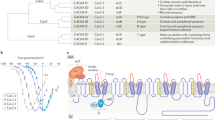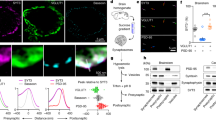Abstract
Transmitter release is triggered by highly localized, transient increases in the presynaptic Ca2+ concentration ([Ca2+]). Rapidly decaying [Ca2+] elevations were generated using Ca2+ uncaging techniques, and [Ca2+] was measured with a low-affinity Ca2+ indicator in a giant presynaptic terminal, the calyx of Held, in rat brain slices. The rise time and amplitude of evoked excitatory postsynaptic currents (EPSCs) depended on the half-width of the fluorescence transient, which was predicted by a five–binding site model of a Ca2+ sensor having relatively high affinity (Kd ∼13 μM). Very fast [Ca2+] transients (half-width <0.5 ms) evoked EPSCs similar to those elicited by a single action potential (AP) in the same synapse. Triggering release with dual [Ca2+] transients of variable amplitudes demonstrated the supralinear transfer function of the sensor. The sensitivity of release to the time course of the [Ca2+] transient may contribute to mechanisms by which the presynaptic AP waveform controls synaptic strength.
This is a preview of subscription content, access via your institution
Access options
Subscribe to this journal
Receive 12 print issues and online access
$209.00 per year
only $17.42 per issue
Buy this article
- Purchase on Springer Link
- Instant access to full article PDF
Prices may be subject to local taxes which are calculated during checkout







Similar content being viewed by others
References
Katz, B. & Miledi, R. The measurement of synaptic delay, and the time course of acetylcholine release at the neuromuscular junction. Proc. R. Soc. Lond. B 161, 483–495 (1965).
Barrett, E.F. & Stevens, C.F. The kinetics of transmitter release at the frog neuromuscular junction. J. Physiol. (Lond.) 227, 691–708 (1972).
Zucker, R.S. Exocytosis: a molecular and physiological perspective. Neuron 17, 1049–1055 (1996).
Neher, E. Vesicle pools and Ca2+ microdomains: new tools for understanding their roles in neurotransmitter release. Neuron 20, 389–399 (1998).
Augustine, G.J., Santamaria, F. & Tanaka, K. Local calcium signaling in neurons. Neuron 40, 331–346 (2003).
Roberts, W.M., Jacobs, R.A. & Hudspeth, A.J. Colocalization of ion channels involved in frequency selectivity and synaptic transmission at presynaptic active zones of hair cells. J. Neurosci. 10, 3664–3684 (1990).
Llinás, R., Sugimori, M. & Silver, R.B. Microdomains of high calcium concentration in a presynaptic terminal. Science 256, 677–679 (1992).
DiGregorio, D.A., Peskoff, A. & Vergara, J.L. Measurement of action potential-induced presynaptic calcium domains at a cultured neuromuscular junction. J. Neurosci. 19, 7846–7859 (1999).
Yazejian, B., Sun, X.P. & Grinnell, A.D. Tracking presynaptic Ca2+ dynamics during neurotransmitter release with Ca2+-activated K+ channels. Nat. Neurosci. 3, 566–571 (2000).
Augustine, G.J., Charlton, M.P. & Smith, S.J. Calcium entry and transmitter release at voltage-clamped nerve terminals of squid. J. Physiol. (Lond.) 367, 163–181 (1985).
Wheeler, D.B., Randall, A. & Tsien, R.W. Changes in action potential duration alter reliance of excitatory synaptic transmission on multiple types of Ca2+ channels in rat hippocampus. J. Neurosci. 16, 2226–2237 (1996).
Borst, J.G.G. & Sakmann, B. Effect of changes in action potential shape on calcium currents and transmitter release in a calyx-type synapse of the rat auditory brainstem. Phil. Trans. R. Soc. Lond. B 354, 347–355 (1999).
Sabatini, B.L. & Regehr, W.G. Control of neurotransmitter release by presynaptic waveform at the granule cell to Purkinje cell synapse. J. Neurosci. 17, 3425–3435 (1997).
Bollmann, J.H., Sakmann, B. & Borst, J.G.G. Calcium sensitivity of glutamate release in a calyx-type terminal. Science 289, 953–957 (2000).
Schneggenburger, R. & Neher, E. Intracellular calcium dependence of transmitter release rates at a fast central synapse. Nature 406, 889–893 (2000).
Datyner, N.B. & Gage, P.W. Phasic secretion of acetylcholine at a mammalian neuromuscular junction. J. Physiol. (Lond.) 303, 299–314 (1980).
Van der Kloot, W. The kinetics of quantal releases during end-plate currents at the frog neuromuscular junction. J. Physiol. (Lond.) 402, 605–626 (1988).
Lin, J.-W. & Faber, D.S. Modulation of synaptic delay during synaptic plasticity. Trends Neurosci. 25, 449–455 (2002).
Zucker, R.S. & Regehr, W.G. Short-term synaptic plasticity. Annu. Rev. Physiol. 64, 355–405 (2002).
Rozov, A., Burnashev, N., Sakmann, B. & Neher, E. Transmitter release modulation by intracellular Ca2+ buffers in facilitating and depressing nerve terminals of pyramidal cells in layer 2/3 of the rat neocortex indicates a target cell-specific difference in presynaptic calcium dynamics. J. Physiol. (Lond.) 531, 807–826 (2001).
Blatow, M., Caputi, A., Burnashev, N., Monyer, H. & Rozov, A. Ca2+ buffer saturation underlies paired pulse facilitation in calbindin-D28k-containing terminals. Neuron 38, 79–88 (2003).
Felmy, F., Neher, E. & Schneggenburger, R. Probing the intracellular calcium sensitivity of transmitter release during synaptic facilitation. Neuron 37, 801–811 (2003).
Bertram, R., Sherman, A. & Stanley, E.F. Single-domain/bound calcium hypothesis of transmitter release and facilitation. J. Neurophysiol. 75, 1919–1931 (1996).
Yamada, W.M. & Zucker, R.S. Time course of transmitter release calculated from simulations of a calcium diffusion model. Biophys. J. 61, 671–682 (1992).
Atluri, P.P. & Regehr, W.G. Determinants of the time course of facilitation at the granule cell to Purkinje cell synapse. J. Neurosci. 16, 5661–5671 (1996).
Matveev, V., Sherman, A. & Zucker, R.S. New and corrected simulations of synaptic facilitation. Biophys. J. 83, 1368–1373 (2002).
Heidelberger, R., Heinemann, C., Neher, E. & Matthews, G. Calcium dependence of the rate of exocytosis in a synaptic terminal. Nature 371, 513–515 (1994).
Hsu, S.-F., Augustine, G.J. & Jackson, M.B. Adaptation of Ca2+-triggered exocytosis in presynaptic terminals. Neuron 17, 501–512 (1996).
Landò, L. & Zucker, R.S. Ca2+ cooperativity in neurosecretion measured using photolabile Ca2+ chelators. J. Neurophysiol. 72, 825–830 (1994).
Helmchen, F., Borst, J.G.G. & Sakmann, B. Calcium dynamics associated with a single action potential in a CNS presynaptic terminal. Biophys. J. 72, 1458–1471 (1997).
Xu, T., Naraghi, M., Kang, H. & Neher, E. Kinetic studies of Ca2+ binding and Ca2+ clearance in the cytosol of adrenal chromaffin cells. Biophys. J. 73, 532–545 (1997).
Dodge, F.A., Jr & Rahamimoff, R. Co-operative action of calcium ions in transmitter release at the neuromuscular junction. J. Physiol. (Lond.) 193, 419–432 (1967).
Felmy, F., Neher, E. & Schneggenburger, R. The timing of phasic transmitter release is Ca2+-dependent and lacks a direct influence of presynaptic membrane potential. Proc. Natl. Acad. Sci. USA 100, 15200–15205 (2003).
Neher, E. & Sakaba, T. Combining deconvolution and noise analysis for the estimation of transmitter release rates at the calyx of Held. J. Neurosci. 21, 444–461 (2001).
Sätzler, K. et al. Three-dimensional reconstruction of a calyx of Held and its postsynaptic principal neuron in the medial nucleus of the trapezoid body. J. Neurosci. 22, 10567–10579 (2002).
Slutsky, I. et al. Use of knockout mice reveals involvement of M2-muscarinic receptors in control of the kinetics of acetylcholine release. J. Neurophysiol. 89, 1954–1967 (2003).
Wu, L.-G. & Borst, J.G.G. The reduced release probability of releasable vesicles during recovery from short-term synaptic depression. Neuron 23, 821–832 (1999).
Augustine, G.J. Regulation of transmitter release at the squid giant synapse by presynaptic delayed rectifier potassium current. J. Physiol. (Lond.) 431, 343–364 (1990).
Byrne, J.H. & Kandel, E.R. Presynaptic facilitation revisited: state and time dependence. J. Neurosci. 16, 425–435 (1996).
Geiger, J.R.P. & Jonas, P. Dynamic control of presynaptic Ca2+ inflow by fast-inactivating K+ channels in hippocampal mossy fiber boutons. Neuron 28, 927–939 (2000).
Meinrenken, C.J., Borst, J.G.G. & Sakmann, B. Calcium secretion coupling at calyx of Held governed by nonuniform channel-vesicle topography. J. Neurosci. 22, 1648–1667 (2002).
Fernández-Chacón, R. et al. Synaptotagmin I functions as a calcium regulator of release probability. Nature 410, 41–49 (2001).
Atwood, H.L. & Karunanithi, S. Diversification of synaptic strength: presynaptic elements. Nat. Rev. Neurosci. 3, 497–516 (2002).
Jahn, R., Lang, T. & Südhof, T.C. Membrane fusion. Cell 112, 519–533 (2003).
Millet, O., Bernadó, P., Garcia, J., Rizo, J. & Pons, M. NMR measurement of the off rate from the first calcium-binding site of the synaptotagmin I C2A domain. FEBS Lett. 516, 93–96 (2002).
Davis, A.F. et al. Kinetics of synaptotagmin responses to Ca2+ and assembly with the core SNARE complex onto membranes. Neuron 24, 363–376 (1999).
Borst, J.G.G. & Sakmann, B. Calcium current during a single action potential in a large presynaptic terminal of the rat brainstem. J. Physiol. (Lond.) 506, 143–157 (1998).
Taschenberger, H. & von Gersdorff, H. Fine-tuning an auditory synapse for speed and fidelity: developmental changes in presynaptic waveform, EPSC kinetics, and synaptic plasticity. J. Neurosci. 20, 9162–9173 (2000).
Pattillo, J.M., Artim, D.E., Simples, J.E., Jr & Meriney, S.D. Variations in onset of action potential broadening: effects on calcium current studied in chick ciliary ganglion neurones. J. Physiol. (Lond.) 514, 719–728 (1999).
Ishikawa, T. et al. Distinct roles of Kv1 and Kv3 potassium channels at the calyx of Held presynaptic terminal. J. Neurosci. 23, 10445–10453 (2003).
Acknowledgements
We thank J.G.G. Borst, R.M. Bruno, E. Neher and R.S. Zucker for helpful discussions and comments on an earlier version of the manuscript, and M. Kaiser, R. Rödel and K. Schmidt for expert technical assistance. We consistently used a calibrated lot (#3491) of OGB-5N, of which a part was kindly provided by T. Euler and K. Svoboda.
Author information
Authors and Affiliations
Corresponding author
Ethics declarations
Competing interests
The authors declare no competing financial interests.
Supplementary information
Supplementary Fig. 1
[Ca2+] relaxation model (PDF 238 kb)
Supplementary Fig. 2
Correlation between EPSC amplitude and the peak and half-width of ΔF/F transients. (PDF 340 kb)
Supplementary Fig. 3
Ca2+ sensor model. (PDF 237 kb)
Supplementary Table 1
Kinetic rate constants used in the [Ca2+] relaxation model. (PDF 103 kb)
Rights and permissions
About this article
Cite this article
Bollmann, J., Sakmann, B. Control of synaptic strength and timing by the release-site Ca2+ signal. Nat Neurosci 8, 426–434 (2005). https://doi.org/10.1038/nn1417
Received:
Accepted:
Published:
Issue Date:
DOI: https://doi.org/10.1038/nn1417
This article is cited by
-
Graphdiyne oxide enhances the stability of solid contact-based ionselective electrodes for excellent in vivo analysis
Science China Chemistry (2019)
-
Synaptic Multivesicular Release in the Cerebellar Cortex: Its Mechanism and Role in Neural Encoding and Processing
The Cerebellum (2016)
-
Functional contributions of the plasma membrane calcium ATPase and the sodium–calcium exchanger at mouse parallel fibre to Purkinje neuron synapses
Pflügers Archiv - European Journal of Physiology (2013)
-
Control of neurotransmitter release: From Ca2+ to voltage dependent G-protein coupled receptors
Pflügers Archiv - European Journal of Physiology (2010)



